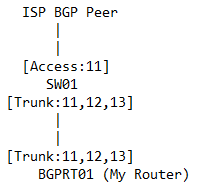I struggle a bit with BGP route dampaning. I try to find out which events inside of our network can trigger the route dampaning mechanism at the ISP site.
I break down my topology to the very basic.
- VLAN 11: Interconnection network between ISP and my router. This network is used for the peering.
- VLAN 12: iBGP connection (not relevant for the question)
- VLAN 13: network advertised by my router.
My concern is about the dampaning of our network at ISP site. As you can see, with this topology the BGP neighbors are not directly connected. So I have multiple possibilities of interruptions (not only link flapping). I try to find out how issues along the path influence the BGP peering, especially the dampaning.
I created a lab with the topology above to test and did 2 tests for the beginning.
- When unplugging and re-plugging the physical link at BGPRT01 site, i see that the penalty is added, etc. as expected. When it exceeds the suppress-limit the route is dampened and removed from the routing table.
So far so good. Next test...
- When removing vlan 11 from SW1 port facing towards BGPRT01 no dampening takes place. After the hold time expires the BGP session is closed, thats it. When adding back the vlan the session is reestablished, thats it. nothing else. If i add the vlan back before the hold time expires nothing special happen.
I would like to know what are the technical events which are responsible to consider a route as instable? Are there events when two eBGP peers are not directly connected which can leads to dampening my route? I read somewhere when receiving a WITHDRAW and an UPDATE for a route. This might be true for example when two ISPs speaks together about a route from another party. But in my setup is seems more like receiving an OPEN message before the hold-time expires?

